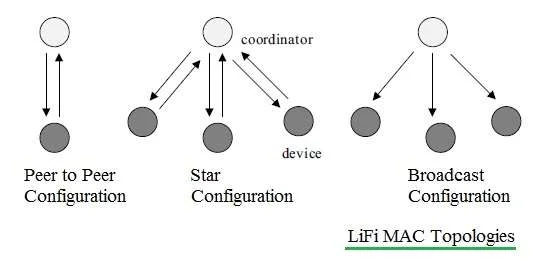LiFi tutorial-LiFi network, protocol, PHY, MAC, bands, modulation
This page of tutorials section covers LiFi system basics. The LiFi tutorial covers LiFi network architecture, LiFi protocol stack, LiFi PHY, LiFi MAC, LiFi bands, LiFi modulation types (OOK, VPPM, CSK).
LiFi is the short form of "Light Fidelity". It works on the principle of Visible Light Communication (i.e. VLC). The network is also referred as VPAN or VLC Personal Area Network. The VLC transmits data by intensity modulation. It uses LEDs and Laser diodes(or photo detectors) at transmit and receive ends respectively. It works in 380 nm to 780 nm optical band which is visible light and hence the name VLC.
The VLC standard or VPAN standard defines three classes of devices viz. infrastructure, mobile and vehicle. These devices operate in one of the three topologies mentioned below. The different device has different coverage range, data rate and other requirements.

Fig-1: LiFi network topologies
It works in three modes as mentioned above in figure-1. In star topology, communication is established between central controller (i.e. coordinator) and devices. In peer to peer topology, one of the device should become coordinator at the time of establishing association.
Each device or coordinator has unique 64 bit address. Device can use 16 bit address also upon request at the time of establishing association with coordinator.
LiFi Protocol Stack

Fig-2: LiFi Protocol Stack
The figure-2 depicts protocol stack used in a typical VPAN device.
As shown protocol stack consists of PHY, MAC and upper layers.
Physical layer houses light transceiver. PHY switch housed in PHY layer interfaces with optical SAP which connects
it to the optical medium. The optical medium composed of one or multiple optical sources or
optical detectors (e.g. laser diodes or photodiodes).
MAC layer provides channel access for all types of data and control message transmissions.
Upper layer consists of network layer and application layer.
Network layer takes care of providing network configuration, network manipulation, message routing etc.
Application layer takes care of providing intended functionality as needed by the VPAN or LiFi
device.
DME (Device Management Entity) is also supported by LiFi or VPAN network architecture.
It makes interfacing between dimmer and PHY/MAC a reality.
LiFi PHY
There are three types of physical layer configurations supported in VLC or LiFi System Viz. PHY-I, PHY-II, PHY-III.
Different rates can be achieved in different configurations. They can be used indoor or outdoor.
Refer LiFI PHYSICAL LAYER➤.
LiFi MAC
MAC layer takes care of resource management i.e. allocation of channels, IDs as well as entire network management. Refer LiFi MAC LAYER➤.
LiFi Modulation Types-OOK, VPPM, CSK
There are different modulation schemes used in different physical layer modes.
OOK stands for On Off Keying, VPPM stands for Variable Pulse Position Modulation and
CSK stands for Color Shift Keying.
READ MORE➤.
Applications of LiFi or VLC system

There are many applications of LiFi or VLC system as lighting and data communications.
Typical among them are lighting, signboards, street lights, vehicles and traffic signals or lights.
The figure mentions emerging application of LiFi for internet data communication.
It has also become popular due to wide adoption of IoT based technologies.
READ MORE➤.
Benefits of LiFi System
Following are the benefits of LiFi system:
• It transfers data very rapidly.
• It transfers data securely as it can be used in Line of Sight mode of
optical signal. It does not pierce through the walls and hence it can not be easily intruded by hackers.
• It uses much low power for transmission compare to other systems such as WiFi.
Note: Information provided on this page is derived from IEEE 802.15.7-2011 draft version. The standard describes PHY layer and MAC layer of Short Range Wireless Optical Communication using Visible Light. The standard is also referred as VPAN or VLC-PAN. Here 'V' or 'VLC' stands for Visible Light Communication. Pls. refer latest standard specifications published time to time by IEEE for any updates.
LiFi Technology Related Products
For LiFi technology related products and LiFi technology related resources one can visit LiFi.co .
Similar posts on Li-Fi
Data Over Light basics
What is Solar LiFi?
Difference between LiFi Internet and WiFi Internet
